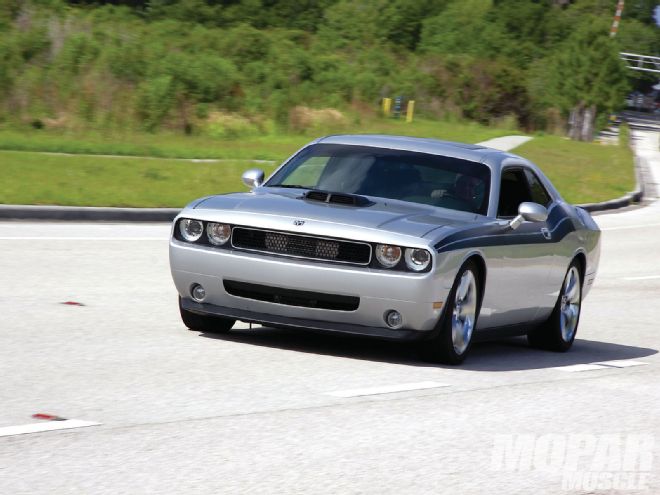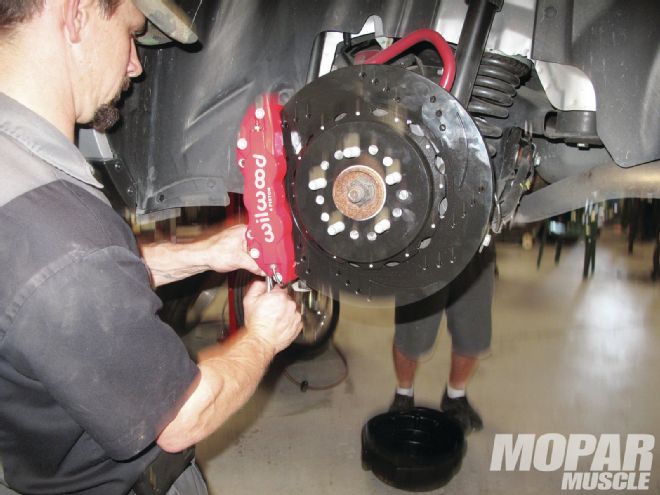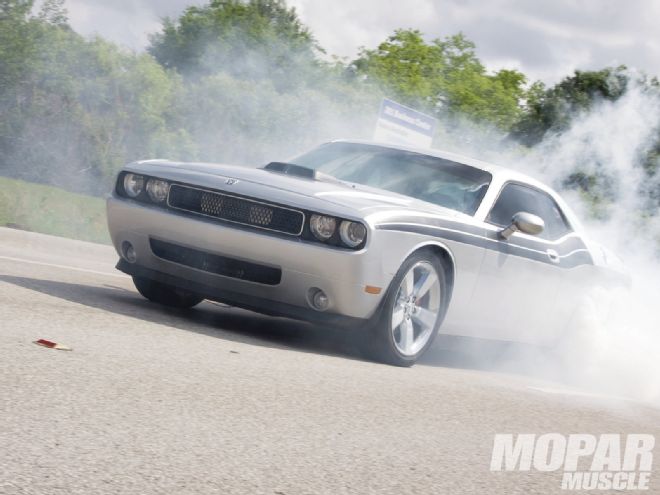
Mopar enthusiasts are fortunate these days to not only have an abundance of parts available to maintain and upgrade their classic cars, but to also have some impressive new iron available directly from Chrysler Corporation dealerships. And while you may have your own opinion as to how late-model Mopars compare to their antique counterparts, the performance of these newer vehicles is difficult to deny. New Mopars like the Charger and Challenger come equipped with an impressive array of performance, safety, and convenience features right from the factory, and though heavier than their elder counterparts, easily outperform muscle cars from the '60s and '70s. And while our '09 Challenger R/T has been a blast to drive even in factory form, we haven't been able to resist the urge to make improvements.

At first, it was difficult to find parts for the new Challenger (and other LX platform cars), but the aftermarket has quickly caught up offering a plethora of performance and appearance upgrades for the new Mopars. And while so far we've concentrated our efforts on making more power with a ProCharger kit, improving shifts with a transmission from Gearstar Performance, and enhancing handling and stance with an Eibach sport suspension kit, we felt it was time to install larger disc brakes from Wilwood Engineering.
Of all the systems found on a high-performance automobile, the brake system is likely the most overlooked. Most car owners simply think that because the brakes don't make the car any faster, they should leave them alone so long as they're working properly. We guess this mentality comes from Mopar's drag racing heritage, as drag cars can benefit from the reduced drag and lighter rotating weight of very light brake components, but for most all-around street or dual-purpose cars, bigger brakes can greatly enhance a car's all-around capabilities, including safety.
Another reason to consider upgrading the brakes of your car is for appearance. Like it or not, many of these newer Mopars will never really see track duty, but serve as weekend cruisers just like older muscle cars did. Not everyone races, especially these days, but most people who are into their cars want them to have the image of high-performance, and with larger diameter, open wheels being popular even from the factory, big brakes is a visible way to show off your car's muscle. And while we love the appearance of the Wilwood cross-drilled and slotted rotors and big, red, six-piston front and four-piston rear calipers, the real reason we're installing them is for the performance.
 1 The new Dodge Challenger is a well-mannered performance vehicle, but we’re not into leaving our cars stock for long. Dubbed “Project Voided Warranty” around the office, we’ve already added a ProCharger supercharger kit to our car as well as a performance aftermarket transmission and converter, and lower sport suspension. This month we’ll add new front and rear big brake kits from Wilwood.
1 The new Dodge Challenger is a well-mannered performance vehicle, but we’re not into leaving our cars stock for long. Dubbed “Project Voided Warranty” around the office, we’ve already added a ProCharger supercharger kit to our car as well as a performance aftermarket transmission and converter, and lower sport suspension. This month we’ll add new front and rear big brake kits from Wilwood.
Better braking capability can greatly enhance a vehicle's performance in both daily driving and during road-course or autocross competition. Being able to brake later, and stop quicker when needed, means that the vehicle can maintain a higher average speed whether around a track or on the way to the parts store. Of course other factors help determine the braking performance of a car, mainly road conditions, suspension limitations, and the grip of the tires. Tires of softer compounds will allow the braking system to work to its potential, allowing the brakes to really work and thereby reducing stopping distances. To the normal driver, this might not make much difference, but if you like to drive aggressively, you'll definitely like better brakes.
Even older Mopar A-Bodies with nine-inch drum brakes would usually stop in decent amount of distance, once, but braking inadequacies aren't revealed until the brakes are used time after time and heat is built up in the components. Once this happens both drum and disc brakes will experience some level of fade, and braking distances will be increased, sometimes dramatically. And though the factory four-wheel disc brakes on the new Challenger are certainly far better than the drum brakes found on earlier Mopars, there is still noticeable fade and increased stopping distance when we repeatedly brake aggressively. Even with stock 20-inch diameter wheels and tires, we felt that our improvements in the acceleration, handling, and top speed of this car necessitated better brakes.
Luckily, Wilwood offers front and rear disc brake kits for the new LX Mopars, and a quick check of their website confirmed that their brakes would fit our '09 Challenger. In fact, we found Wilwood's website easy to navigate, only requiring the make, model, and year of our car to immediately show the options available. Known for their impressive race oriented braking systems, the kits available for the Challenger all offer huge 14.25-inch diameter front and rear rotors, with optional drilled and slotted rotors available. Their part number 140-11764-DR front kit offers six-piston calipers powdercoated in red, and part number 140-11765-DR rear kit includes four-piston calipers also powdercoated in red. Though not inexpensive at $2511.54 for the front kit and $2268.11 for the rear kit (retail at time of print), we've found Wilwood components to be worth the expense in terms of quality and performance. Eager to install and test our new brakes, we took our car and parts to nearby Inline Performance Specialists to perform the work.
Performing a four-wheel brake swap shouldn't be considered "easy" work for an amateur mechanic, especially given the obvious safety implications. But while the Wilwood instructions recommended taking the car to a professional shop for the brake work, there was really nothing involved that an average mechanic couldn't accomplish in his or her driveway with some basic hand tools. The rotors did require aviation safety wire be installed, which is somewhat of an art, but with a little practice anyone can learn the skill. Both the front and rear Wilwood kits come with all the brackets and hardware needed to install the brakes, and the instructions are clear and concise.
Using the lift at Inline Performance, technician Scott Pitts quickly had our factory brakes removed, and got busy prepping the new Wilwood rotors by using the provided fasteners to attach them to the hubs, and installing safety wire as an extra precaution to prevent the bolts from backing out. We found the Wilwood kit to be complete and the instructions easy to follow as we replaced our factory brakes with the new components. It always takes a little extra time to take photographs when doing work for a magazine article, but even so Scott easily had all four brakes installed and bled in about eight hours and we were ready for a test drive.
After testing the brakes at slower speeds to ensure everything worked properly, we followed Wilwood's break-in procedure by making several stops from high speed one after another, until brake fade is noticed. This procedure seats the pads, establishes wear patterns, and builds heat to properly "break" in the components (no pun intended) so they are ready to use. With the '09 Dodge Challenger R/T having a claimed factory 60 to zero braking distance of 125 feet, we felt these brakes would certainly perform better than that, provided our factory 20-inch Goodyear Eagle tires would hold at least some of the extra bite. With the help of Associate Editor Kevin Diossi, we loaded up our high-tech radar assisted brake testing equipment and went to the Mopar Muscle proving grounds (a road near our office leading to an abandoned business park).
After a couple of equipment calibration runs, we began our test of the Wilwood four-wheel disc brakes. These brakes are compatible with the factory master cylinder and anti-lock braking system, so once we reached 60 mph on our test course we would aggressively apply the car's brakes until we felt the ABS engage. During our baseline tests of the factory brakes, we'd get about three or four good stops from 60 mph before the brakes would fade and stopping distance would increase to the 135-foot range. With the first test of our big Wilwood brakes, we accomplished a stopping distance of 116 feet, nearly ten feet shorter than the factory brakes. Subsequent tests netted a best distance of 111 feet on our third attempt, and after making six or more tests the brakes faded slightly, but still stopped our Challenger in less than 120 feet.
During our testing it was very apparent that the tires were our limiting factor, and we feel we could have accomplished even shorter braking distances with softer, more aggressive tires and perhaps better road conditions. Even so, the Wilwood brakes definitely outperform the factory brakes, providing shorter, safer, and more consistent stops. In addition to the improved performance, these brakes are one of the most noticed upgrades we've accomplished on our Challenger so far, getting attention on the road and at gas stations behind the car's factory five-spoke 20-inch wheels.